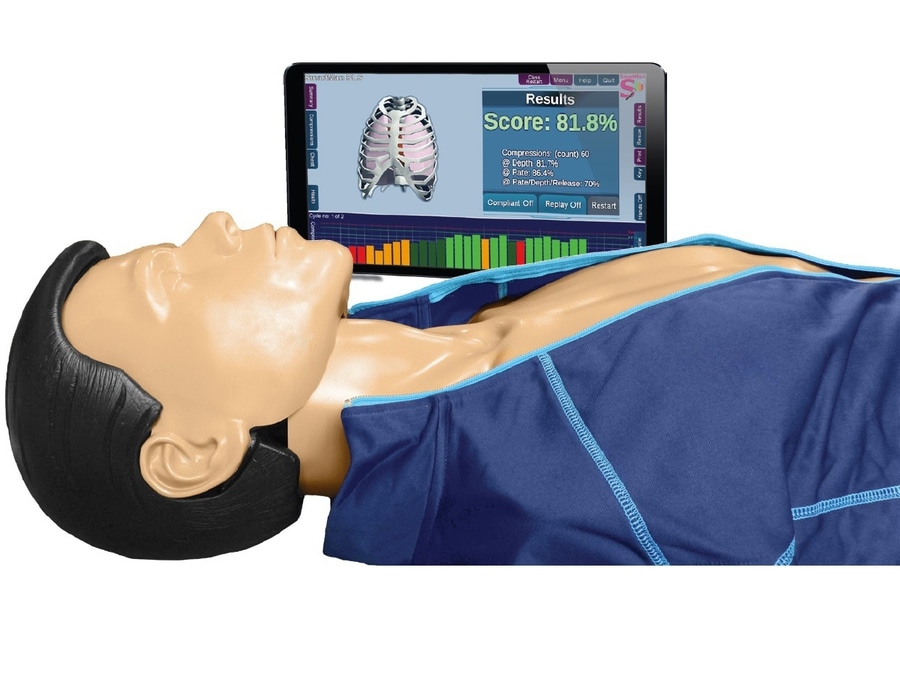
#Product Trends
Real-Time Feedback during Cardiopulmonary Resuscitation (CPR) Training and Testing Improves Survival in Out-of-Hospital Sudden Cardiac Arrest Patients.
Real-Time Feedback during Cardiopulmonary Resuscitation (CPR) Training and Testing Improves Survival in Out-of-Hospital Sudden Cardiac Arrest Patients.
Angelo Salvucci, MD, FACEP, FAEMS
Medical Director
Santa Barbara County Emergency Medical Services
September 21, 2018
Abstract
This a replication and extension of a previous study that aimed to increase cardiac arrest survival rates by utilizing the SmartMan manikin simulator to improve cardiopulmonary resuscitation (CPR) training across an entire system. CPR performance data was reviewed and overall survival and Cerebral Performance Category (CPC) scores were compared to the national Cardiac Arrest to Enhance Survival (CARES) cohort. After a focused CPR training program the percentage of cardiac arrest patients who survived to hospital discharge within the study area, compared to the prior two-year benchmark, increased by 122% - from 8.1% to 18.0%. The increase in percentage of survivors for the duration of the training program, 2013-2016, when compared to the CARES cohort, was statistically significant (9.9% vs. 15.5%, p<.01). The increase in number of survivors with CPC scores of 1 or 2 (favorable neurological function) compared to the CARES cohort was also statistically significant (p<.01) (t-value 8.21761, p-value .000088). This study showed that the results achieved in the previous study could be replicated and improved upon. Training with the SmartMan manikin simulator with its visual color feedback system was successful in increasing the number of cardiac arrest survivors.
Background:
Cardiovascular disease is responsible for an estimated 30% of global mortality, and 50% of those deaths are Sudden Cardiac Death.1 Survival from out-of-hospital cardiac arrest is less than 1% globally and 5% in the United States and has not improved over the last 30 years.2 Human and animal studies have identified continuous high-quality chest compressions to be an essential component in successful resuscitation.3 In our previous work we found that: 1) chest compression performance by on-duty EMS personnel with traditional CPR training was poor but improved substantially after a brief training session with the SmartMan visual-feedback training manikin simulator4, and 2) a system-wide SmartMan CPR training project improved cardiac arrest survival.5
The studies were performed in a California, USA region with an overall population of 1.4 million. Regional Emergency Medical Services (EMS) treats approximately 600 cardiac arrests from presumed cardiac etiology annually. There are two independent systems within the region. System 2 EMS began measuring cardiac arrest survival rates upon joining the nation-wide Cardiac Arrest Registry to Enhance Survival (CARES) program in 2010. In the first two years after joining this program survival rates were at or below the CARES cohort average and substantially less than in System 1. This investigation in System 2 was designed to replicate the improved survival rates reported in System 1.
Objective:
The objective of this study was to determine if the introduction of an EMS system-wide CPR training
program with the SmartMan visual feedback manikin simulator would result in a measureable
improvement in cardiac arrest survival.
Methods:
This was a prospective evaluation of EMS system performance for patients in cardiac arrest. The
intervention evaluated was CPR training with the SmartMan visual feedback manikin simulator.
An EMS CARES Quality Improvement Committee was formed upon joining the CARES program. CPR
performance data was reviewed and compared to the national CARES cohort and those achieved in
System 1. The CARES program provides an objective benchmark as it standardizes cardiac arrest
evaluation and reporting. All counties or cities in the program submit data into a single large
database.
After two years of unsuccessful quality improvement efforts the Committee elected to use the
SmartMan simulator to train all System 2 EMS personnel. The SmartMan system was selected
because: 1) it uniquely provided visual feedback at the conclusion of every compression, 2) it
accurately measured chest compression rate, depth and chest recoil, 3) reliable data from each skill
performance was immediately available for analysis, and 4) it was successfully utilized in System 1.
Training was conducted during December 2011.
In the original implementation in System 1 the activity was to perform 200 compressions with a
minimum score of 80% and recommended refresher training every 6 months. This study in System 2
also used 200 compressions but the target achievement scores was established at 85%, and
refresher training was recommended for every 3 months. Testing of performance levels was
integrated into training. The head trainer reported individual performance scores to administration
and produced summary reports of performance quality levels. Spot checking of skills was done
during annual skills refresher sessions.
The baseline survival rates were from 2011-12, the two years after System 2 had joined the CARES
program. In the National CARES cohort the survival rate for cardiac arrest due to cardiac etiology for
2011 was 11.1% and for 2012 was 10.0%. System 2 was slightly below the national average; 2011
was 8.3% and 2012 was 8.0%. These represent total populations and are not samples.
Results:
There was an immediate and substantial increase in survival rates in cardiac arrest patients. We
compared cardiac arrest survival in System 2 in 2011-12 (benchmark before SmartMan training) to
2013-16 (after SmartMan training); this increased from 8.1% to 18.0%.
Immediate Survival Increase
Introduction of the training showed a direct measurable increase within the first year. Table 1 shows
the year end improvement in survival rates for System 2; a 122% increase in survival.




